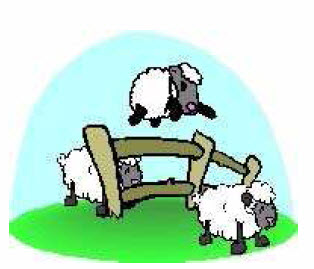counting sheep bfs wyk
来源:互联网 发布:sql server怎么安装 编辑:程序博客网 时间:2024/06/07 02:46
Home PageWeb ContestsProblemsRanklistStatusStatisticsCounting Sheep
Time Limit : 2000/1000ms (Java/Other) Memory Limit : 32768/32768K (Java/Other)
Total Submission(s) : 8 Accepted Submission(s) : 7
Problem Description
A while ago I had trouble sleeping. I used to lie awake, staring at the ceiling, for hours and hours. Then one day my grandmother suggested I tried counting sheep after I'd gone to bed. As always when my grandmother suggests things, I decided to try it out. The only problem was, there were no sheep around to be counted when I went to bed.

Creative as I am, that wasn't going to stop me. I sat down and wrote a computer program that made a grid of characters, where # represents a sheep, while . is grass (or whatever you like, just not sheep). To make the counting a little more interesting, I also decided I wanted to count flocks of sheep instead of single sheep. Two sheep are in the same flock if they share a common side (up, down, right or left). Also, if sheep A is in the same flock as sheep B, and sheep B is in the same flock as sheep C, then sheeps A and C are in the same flock.
Now, I've got a new problem. Though counting these sheep actually helps me fall asleep, I find that it is extremely boring. To solve this, I've decided I need another computer program that does the counting for me. Then I'll be able to just start both these programs before I go to bed, and I'll sleep tight until the morning without any disturbances. I need you to write this program for me.

Creative as I am, that wasn't going to stop me. I sat down and wrote a computer program that made a grid of characters, where # represents a sheep, while . is grass (or whatever you like, just not sheep). To make the counting a little more interesting, I also decided I wanted to count flocks of sheep instead of single sheep. Two sheep are in the same flock if they share a common side (up, down, right or left). Also, if sheep A is in the same flock as sheep B, and sheep B is in the same flock as sheep C, then sheeps A and C are in the same flock.
Now, I've got a new problem. Though counting these sheep actually helps me fall asleep, I find that it is extremely boring. To solve this, I've decided I need another computer program that does the counting for me. Then I'll be able to just start both these programs before I go to bed, and I'll sleep tight until the morning without any disturbances. I need you to write this program for me.
Input
The first line of input contains a single number T, the number of test cases to follow. Each test case begins with a line containing two numbers, H and W, the height and width of the sheep grid. Then follows H lines, each containing W characters (either # or .), describing that part of the grid.
Output
For each test case, output a line containing a single number, the amount of sheep flock son that grid according to the rules stated in the problem description. Notes and Constraints 0 < T <= 100 0 < H,W <= 100
Sample Input
24 4#.#..#.##.##.#.#3 5###.#..#..#.###
Sample Output
63ACcode:#include <algorithm>#include <cstdio>#include <cstring>#include <cmath>#include <iostream>#include <limits.h>#include <vector>using namespace std;#define MAX 50005char map[105][105];int cal[105][105];int dir[4][2]={{1,0},{0,1},{-1,0},{0,-1}};int xx,yy;void bfs(int x,int y){ if(x>=0 && x<xx && y>=0 && y<yy) { if(map[x][y]=='#' && !cal[x][y]) { cal[x][y]=1; for(int i=0; i<4; ++i) bfs(x+dir[i][0],y+dir[i][1]); } }}int main(){ int T; int i,j,k; cin>>T; while(T--) { memset(cal,0,sizeof(cal)); scanf("%d%d",&xx,&yy); for(i=0; i<xx; ++i) { getchar(); for(j=0; j<yy; ++j) //cin>>map[i][j]; scanf("%c",&map[i][j]); } int sum=0; for(i=0; i<xx; ++i) { for(j=0; j<yy; ++j) if(map[i][j]=='#' && cal[i][j]==0)//遇到羊不在一群的羊即没有标记的羊,SUM++ { ++sum; bfs(i,j); } } cout<<sum<<endl; } return 0;}
0 0
- counting sheep bfs wyk
- HDU2952:Counting Sheep(BFS)
- HDU2952:Counting Sheep(BFS)
- 杭电2592Counting Sheep dfs+bfs
- HDU 2952 Counting Sheep(bfs)
- HDU 2952 Counting Sheep ( DFS + BFS )
- Counting Sheep
- Counting Sheep
- hdu2952——Counting Sheep(DFS&&BFS)
- 杭电2952 Counting Sheep(简单BFS过)
- HDU2952 ( Counting Sheep )
- HDU 2952 Counting Sheep
- hdu 2952 Counting Sheep
- HDU2952:Counting Sheep(DFS)
- HDU2952 Counting Sheep
- hdu_2952 Counting Sheep
- hdu2952(DFS Counting Sheep )
- hdu-2952-Counting Sheep
- JQuery.Ajax()的data参数类型
- UICollectionView 单选的实现
- iOS优化25条建议
- 技术差是什么样的体验?在这里仅了解下如何辨别程序员的几种方法。
- Sql基本语句
- counting sheep bfs wyk
- Hanoi Tower
- 数据库sqlite语句
- 可伸缩性/可扩展性(Scalable/scalability)
- 使用hessian进行服务器与客户端通讯
- asp.net中output参数为null问题
- 黑马程序员—OC基础—autorelease的使用
- android加载大图片
- 电子干涉--粒子还是波?


